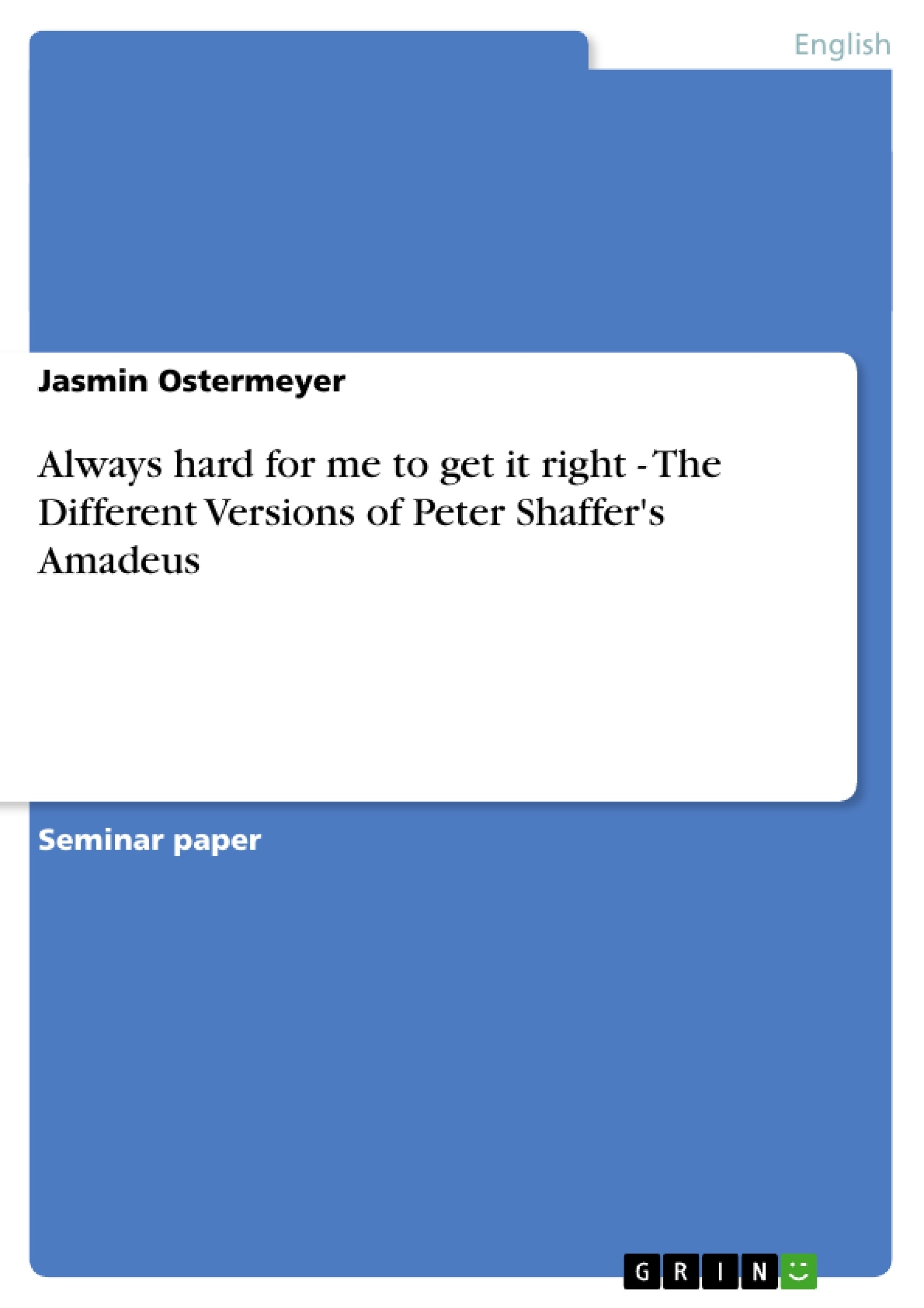Indeed, sometimes I wonder at those writers who display no desire to alter anything when work is revived. And sometimes, too, I envy their seeming certitude - or even their indifference, which may be a form of instinctive wisdom!
Peter Shaffer is certainly none of those writers who do not feel the desire to alter their work. There are six different versions of his playAmadeuswhich have been produced on stage and screen since 1979, whenAmadeusmade its first appearance in the National Theatre of Great Britain, London. The latest version of Shaffer’s play was published in 1999, after being revived and staged in London and New York. Writing and, mainly, re-writing Amadeus has been a process of 20 years in which Shaffer changed not only some aspects of the plot but in the first place of characters and their meaning. The most prominent alternations can be seen at the end of the second act, the final confrontation of the two main characters, Antonio Salieri and Wolfgang Amadeus Mozart. It is especially this scene of their last meeting that Shaffer felthard […] to get right, because he considered it as the play’s structural climax whereas the historical truth - Salieri survived Mozart 34 years,retired, replaced and essentially rejected3- was anticlimactic.
This essay shall investigate the alternations of the last confrontation between the two characters and their impact on one of the major motifs of the play, Salieri’s struggle with God. Therefore, the 1979 original version (published 1980) of Amadeus,the 1981 revised version, which has long been the basis for all presentations around the world, and the recently published 1999 version will be analyzed and compared. The 1984 film version, directed by Milos Forman, will not be taken into considerations because theatre and film are very different forms of art. They work with different techniques and offer different opportunities of presentation. There are losts of changes made for the movie that meet with the conception of presenting a story on screen. A comparison of play and film that does justice to both forms is impossible within in the scope of this essay.4The 1997 version will be excluded as well because it is merely a provisional result for the following ones. The versions of 1998 and 1999 will be treated as a single one because there are only slight differences between them.
Inhaltsverzeichnis (Table of Contents)
- Introduction
- The Characters
- Antonio Salieri
- Wolfgang Amadeus Mozart
- The 'Final Encounter' and its Versions
- 1979/80: The Original Version
- 1981: The Revised Version
- 1998/1999: Taking It up again
- Conclusion
Zielsetzung und Themenschwerpunkte (Objectives and Key Themes)
This essay aims to investigate the different versions of Peter Shaffer's play Amadeus, focusing on the changes in the final confrontation between the two main characters, Antonio Salieri and Wolfgang Amadeus Mozart. The analysis will explore how these alterations impact one of the play's key motifs, Salieri's struggle with God. The original 1979 version, the 1981 revised version, and the 1999 version will be compared and contrasted.
- The evolution of the final confrontation between Salieri and Mozart
- The impact of these changes on Salieri's struggle with God
- The relationship between talent, morality, and divine favor
- The portrayal of Mozart as a genius and Salieri as a tormented observer
- The subjective nature of storytelling and the role of the narrator
Zusammenfassung der Kapitel (Chapter Summaries)
- Introduction: The essay introduces the concept of rewriting and its significance in the context of Shaffer's play. It discusses the six different versions of Amadeus and highlights the focus on the final encounter between Salieri and Mozart. It establishes the scope of the analysis, outlining the specific versions to be considered.
- The Characters: This chapter delves into the portrayal of Antonio Salieri, highlighting his role as both the main character and the narrator of the subplot. The author presents two sides of Salieri: the young, ambitious court composer and the older, tormented man wrestling with his past. Salieri's relationship with God, his artistic pursuits, and his encounters with Mozart are explored.
Schlüsselwörter (Keywords)
This essay centers on key themes of artistic genius, divine favor, moral conflict, subjective narration, and the evolution of dramatic works. It analyzes the contrasting personalities of Salieri and Mozart, their complex relationship, and the impact of Mozart's talent on Salieri's struggle with God. The analysis focuses on the development of the final confrontation between the two characters and its implications for the play's overall message.
- Arbeit zitieren
- Jasmin Ostermeyer (Autor:in), 2005, Always hard for me to get it right - The Different Versions of Peter Shaffer's Amadeus, München, GRIN Verlag, https://www.grin.com/document/48732




